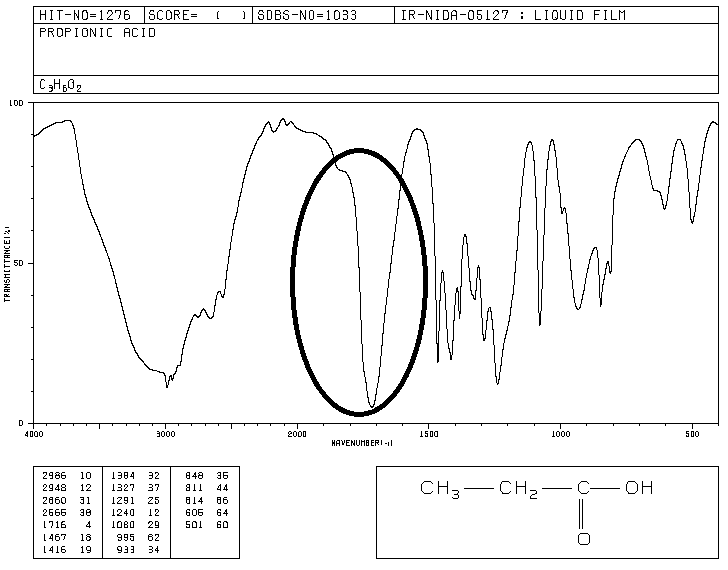How could you distinguish between the following pair of compounds from their IR spectra? #"HOCH"_2"CH"_2"CHO"# (3-hydroxypropanal) and #"CH"_3"CH"_2"COOH"# (propanoic acid)
1 Answer
The main differences between these molecules' IR spectra are in the
While the alcohol
COMPARING THE STRUCTURES
Follow the structural formulas from left to right to determine that the structures are:
Notice how the functional groups are clearly different; the left compound has an alcohol hydroxyl and an aldehyde carbonyl group, while the right compound has a carboxylic hydroxyl and a carboxylic carbonyl group.
SIGNIFICANT VIBRATIONAL MOTIONS
To break it down further, consider the ways these compounds can stretch and bend.
It's a good rule of thumb to assume that single bonds can stretch and bend, and double bonds can stretch, but don't bend very well. Also, as an aside, alcohol bends aren't really necessary to consider because their stretches are so distinctive.
Here's what I see. I've bolded the unique motions, and put the frequencies in wavenumbers (Techniques in Organic Chemistry, Mohrig).
3-hydroxypropanal -
#sp^3# #"C"-"H"# bend (alkane) ---#1480~1430# and#1395~"1340 cm"^(-1)# ; medium to weak; sharp#sp^3# #"C"-"H"# stretch (alkane) ---#2990~"2850 cm"^(-1)# ; medium to strong; sharp#\mathbf("C"="O")# stretch (aldehyde) ---#1740~1720# (saturated) and#1715~"1680 cm"^(-1)# (conjugated); medium; sharp#\mathbf("C"-"H")# stretch (aldehyde) ---#2900~2800# and#2800~"2700 cm"^(-1)# ; weak; sharp Fermi doublet#\mathbf("C"-"O")# stretch (alcohol) ---#1300~"1000 cm"^(-1)# ; strong; sharp#\mathbf("O"-"H")# stretch (alcohol) ---#3650~3550# and#3550~"3200 cm"^(-1)# ; medium to strong; broad
propanoic acid -
#sp^3# #"C"-"H"# bend (alkane) ---#1480~1430# and#1395~"1340 cm"^(-1)# ; medium to weak; sharp#sp^3# #"C"-"H"# stretch (alkane) ---#2990~"2850 cm"^(-1)# ; medium to strong; sharp#\mathbf("C"="O")# stretch (carboxylic acid) ---#1725~1700# (saturated) and#1715~"1680 cm"^(-1)# (conjugated); strong; sharp#\mathbf("C"-"O")# stretch (carboxylic acid) ---#1300~"1000 cm"^(-1)# ; strong; sharp#\mathbf("O"-"H")# stretch (carboxylic acid) ---#3200~"2500 cm"^(-1)# ; medium to weak; broad
You should eventually see that the significant differences in the frequencies given above are:
- The carboxylic
#"C"="O"# stretch is generally stronger, slightly more upfield, and broader. - The carboxylic
#"C"="O"# stretch is less broad (spans a smaller range of frequencies near#"3000 cm"^(-1)# )
COMPARING THE SPECTRA
This will become clearer once we examine comparable spectra on this nice website called the SDBS.
Although I couldn't find 3-hydroxypropanal's spectrum, I did find propionaldehyde/propanal's spectrum, which still shows a major difference with the
Pay attention to the circled peak; it's sharp and "well-defined".

The circled peak here is broader and more "smeared". Therein lies the difference!
(Ignore the

